This rifle is pretty much a big mystery – I have virtually no good information on it. Through inspection, we know it is a mechanical copy of the Soviet SVT 38 or 40 – it shares the same exact bolt, locking system, and gas system. Even many aesthetic features like the metal front handguard, muzzle brake, and sights are remarkably similar to those of the SVT. The biggest difference is the magazine, which is a fixed design fed only be stripper clips. The rifle is chambered for the 8x59mm Breda cartridge, and magazine capacity is unknown – probably either 9 or 10 rounds.
The clue that this is a Pavesi rifle comes from the safety lever, which is identical to the safety lever on the Model 1942 Pavesi rifle. The only markings on this piece are two repetitions of the serial number (875), on the receiver and stock. This serial number suggests that a significant number of these rifles may have been made, although I have not seen any other examples, nor any recorded information on when or where they were made, tested, or fielded.
The most interesting diversion from the standard SVT construction is the addition of a leather buffer pad on the back of the receiver. This was clearly added after the rifle was built, as it must be removed before the bolt can be taken out of the action. The details of the receiver cover attachment were also modified from the original SVT, making disassembly and reassembly easier, with the mainspring less prone to kinking as in the SVT.
This example is in the reference collection of the Beretta company in Brescia. Many thanks to them for allowing me to take a look at it!
Pavesi SVT Copy








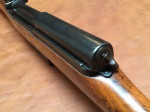






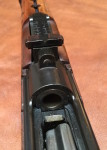
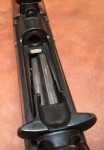
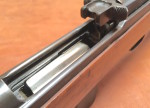
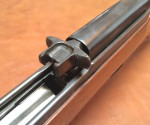



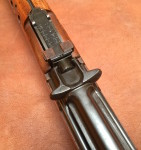

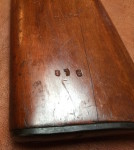


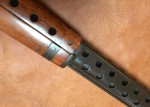

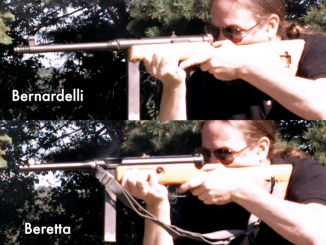
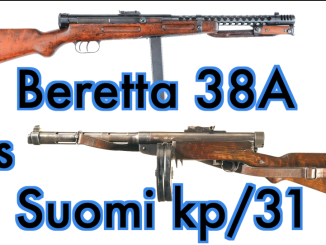
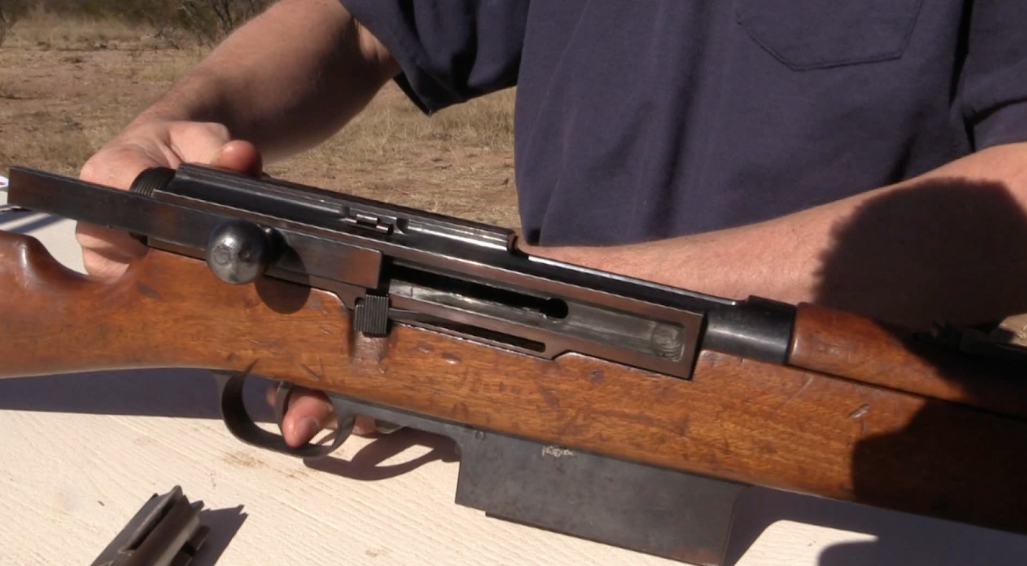
I wonder if this was derived from Italian experience on the Eastern Front? They must have come across a fair few SVT40s.
I find the use of the 8mm Breda a bit puzzling. It’s a very powerful machine gun round. The 6.5mm Carcano round would make for much easier shooting and give the rifle less of a pounding.
“I find the use of the 8mm Breda a bit puzzling.”
I think that it might be supposed to be:
– machine gun crew weapons
– sniper weapon (was 8x59mm cartridge accurate enough for that?)
Notice that muzzle brake is rather based on latter pattern. (4 holes, originally developed for AVT-40 style, but also used on late SVT-40).
Now I checked dimensions of 8×59 vs 7,62×54 (in brackets: data for 8×59 and for 7,62 in mm), interestingly both have similar base diameter (12,49 vs 12,28) however as 8×59 is rebated rim design and 7,62 is rimmed rim diameters differs vastly (11,92 vs 14,31), Breda round is also longer but not very (80,44 vs 76,68) so 7,62 self-loading rifle looks as sane starting point for development of 8×59 of weapon, from cartridge dimension Point-Of-View.
Perhaps this rifle would be good for engaging targets who tend to wear body armor. I can’t imagine that a modern Kevlar vest would protect you from a machinegun round with some slight anti-vehicle capabilities…
Of course, nobody used body armor much during WW2 except USAAF and RAF bomber crews.
A more likely explanation is issue to MG troops using the Breda M1937 HMG in 8 x 59. I suspect it was a self-loader because the Italian Army ordnance department was probably all too aware that the Mannlicher-Carcano M91 rifle action, which was strained to its limits to cope with being redone to handle 7.9 x 57, would probably blow apart in sheer astonishment in 8 x 59.
Also, consider that any self-loading action with a moving bolt/breechblock and recoil springs will inherently have less felt recoil than a manual repeater (bolt-action or otherwise) with a standing breech that doesn’t move until the operator “operates” it.
They may have designed self-loaders in 8 x 59 not so much to increase rate of fire as to prevent bruised or broken shoulders among the users.
cheers
eon
“A more likely explanation is issue to MG troops using the Breda M1937 HMG in 8 x 59.”
Fast solution might be acquiring some Mauser Gewehr or its derivatives from, at the time allied with Italy, Germany – and reworking to 8×59 (as Sweden does converting to 8×63 and thus getting Gevär m/40)
“I can’t imagine that a modern Kevlar vest”
I will not say about Kevlar but modern Russian vests use Aluminium oxide (Al2O3 also known under other names) for example бронежилет 6Б43 – http://army-news.ru/2010/10/bronezhilet-6b43/ – is class 6А (as defined in ГОСТ Р 50744-95) vest meaning that is able to withstand hit from 7.62x54R cartridge with B-32 bullet @ distance of 5-10m from SVD rifle.
The Mauser bolt-action was by WW2 very well known and no longer encumbered by any patents, so it would have been very easy for the Italians to make Mauser type rifles in 8×59 Breda, if they had wanted to, with or even without German help.
As to why Pavesi chose to make the semi-auto prototypes in 8×59 in 1942 is really somewhat puzzling. The cartridge was introduced in 1935 and they had plenty of time to design a new rifle for machine gun crews before 1942. For general issue rifle cartridge the 8×59 was too powerful at least in the historical loading, although it might have been possible to develop a variant with a lighter bullet for rifles.
EW;
It’s not always safe to assume a decision made by an ordnance establishment is made logically. Often, it’s more “empire-building”; the French St. Etienne machine gun, with its reversal of the Hotchkiss piston driving the bolt in the opposite direction by a rack-and-pinion gear, being a case in point.
Pavesi may simply have been trying to upstage Breda, who up to then had been the only company to sell the Italian Army a self-loading rifle (Breda M1935 carbine).
Then again, in Il Duce’s military, the explanation might be even more convoluted than that. One possibility; one or more of Benito’s relations may have been involved.
😉
cheers
eon
It’s a Pavesi Modello 1942, see pg 111 Italian Small Arms of WW1 and WW2 by Ralph Riccio. (Note if anyone on here can contact him, he would like to know about this example, in his book he states so far no surviving example had been found.) Pavesi made a similar Modello 1938 as well.
Mr. Riccio’s source for that identification was an Italian book which I have a copy of (Armi da fuoco portabili delle Forze Armate Italiane. Vol. I: Dal Carcano al FAL). It is incorrect, and was written without actually having an example of the rifle to observe.
Thanks for sharing
that gun raises lots of questions – like at what stage did the prototype arrive in Italy and how?
Although Stalin officially disliked Mussolini and the Fascist approach to achieving socialism, Stalin and his minions were actively cooperating / collaborating with the Axis forces up until Barbarossa began in the middle of 1941 (regardless of Carcano rifles going to Finland).
and Mussolini was fashionably late in showing up for the start of Barbarossa.
Once in Italy, Italian engineering excellence is definitely showing through with the easier dis assembly and improved recoil spring guiding
The Breda round is interesting
The Rim and head are within spitting distance of being the same as the .284 Winchester (or a H&H mag with the belt turned off and the rim rebated down to .470″ diameter)
but case taper is quite pronounced – so the shoulder diameter is smaller than either the .30-06, or the # x 57mm rounds.
so more case head backthrust for equal operating pressure but probably about the same case capacity as an ’06 based case.
D’oh!
from your photos, it looks like the rifle might have floating mag feed lip extensions at the rear of the mag, like Westley Richards .425 rifles to allow the rebated case to rise slightly higher so the bolt engages securely with the flat base of the case, rather than riding over the rebate.
The bright feed lips are much less pronounced than the Westley Richards ones, as the .425 Westley Richards case was radically rebated, with a .545″ diameter case body (same as used by Winchester Remington and Dakota for their super mags) and a .470″ rim
“.425 Westley Richards case was radically rebated”
Photo: http://www.municion.org/Westley/425Westley.htm
“but case taper is quite pronounced”
I would guess it was done to ease extraction – small movement will cause separation of case from chamber walls.
“so more case head backthrust for equal operating pressure but probably about the same case capacity as an ’06 based case.”
Municion states that: Balísticamente apenas se diferencia del 7,92×57 alemán
If I understand correctly: [8×59 Breda] ballistic wise is very small different from 7,92×57 German.
I think the influence of case taper is more pronounced with regard to easy feed and chambering.
Extraction is more complicated, and the sweet spot appears to be around the same or even less taper than a .308
Ackley certainly showed that, with say a .30-30 in a lever action, the strongly tapered standard round would give extraction difficulties long before it got anywhere near loosening primer pockets
however by re-chambering to a minimal case taper .30-30 “Improved” you could keep increasing loads until primers dropped out due to case head expansion – without encountering difficult extraction.
It’s actually notable that although the .425 Westley Richards has only a 10 degree shoulder angle, it has less body taper than almost any of the Ackley etc “improved” cases from the 1940s to 1970s
This was a dangerous game round (it has similar muzzle energy to a .458 Win Mag but a far better reputation for penetration than the .458 Winchester’s rather dubious reputation) where slick feed and extraction were of utmost importance.
Simillarly the .416 Rigby, which forms the parent case for .338 Lapua sniper round – and with a decorative belt stuck onto it, the parent for the largest weatherby mags.
The .416 Rigby case has a 45 degree shoulder angle and minimal (though not as radically minimal as the .425 WR) body taper – it was an “improved” style case, thirty years before Kilbourn and Ackley were “improving” cases.
again, the .416 was designed for use against dangerous game, and still has a good reputation for that use. Although pressures are kept low in all of the British cartridges designed for use in hot climates, Rigby did not see a large taper angle as necessary for easy extraction – if anything they seem to have seen the opposite.
“and with a decorative belt stuck onto it”
Wait, this make more work needed to craft one, if it is NOT necessary why add more work? They far that without belt it would be possible to load that cartridge to wrong rifle?
“The .416 Rigby case has a 45 degree shoulder angle and minimal (though not as radically minimal as the .425 WR) body taper”
For other small angle see .404 Jeffery.
“Ackley certainly showed that, with say a .30-30 in a lever action, the strongly tapered standard round would give extraction difficulties long before it got anywhere near loosening primer pockets”
I don’t think about problems caused by wrong powder charge, but rather dirty chamber.
is: “(…)They far that(…)”
should be: “(…)They fear that(…)”
The Weatherby belts were a superfluous marketing gimmick, that potentially interfered with smooth magazine feed.
Belts were expected with “magnums” at the time, and all of the Wetherby line apart from his long forgotten “improved” .220 swift (.220 swift already had too much powder capacity), had belts, even the .240 which is based on a belted ’06 case and the .224 Weatherby which is a belted zipper / .225 Winchester (necked down .30-30) case.
There was no danger from wrongly chambering a .378 weatherby in a .416 Rigby, there was more than enough blowby space if the thing actually chambered
and the later .460 Weatherby wouldn’t have fit. The .416 Weatherby came much much later.
Dangers do exist, for example a .222 in a .223 chamber, or a .223 in a .222mag or 5.6 x 50 chamber, or .270 win in a .280 Rem chamber. In each of those there is potential for a case head separation due to excess headspace if the case fires.
Regarding extraction
high pressures and hot dirty chambers are two aspects of the same problem.
certainly it would seem logical that a greater taper will extract better than a lesser taper,
but, as Ackley’s experiments show, extraction forces increase if case taper is increased beyond a certain point
so, there’s a question of where the sweet spot of case taper might lie?
and the answer to that appears to be somewhere around the taper of the .308 – or even less.
In terms of feed, the smaller the pointy end of a loaded round and the bigger the funnel you are trying to put it in, the more likely it is to go in (assuming that you can keep the pointy end raised up in the mag to start it feeding).
Feeding into a dirty chamber is dealt with by diametrical clearance – the case is several thou smaller diameter than the smallest chamber.
There is also typically three to six thou clearance for the case neck to expand to release the bullet.
Ideally the headspace surface has less than three thou clearance, although military tolerances often allow six thou clearance.
The case capacity is going to be within about 10% of the 7.92x57mm, so unless the Breda round was loaded to drastically higher pressures (unlikely) the performance will be comparable for the same weight of bullet and same length of barrel.
7.92 x 57 is certainly no slouch in ballistic terms
“Although Stalin officially disliked Mussolini and the Fascist approach to achieving socialism, Stalin and his minions were actively cooperating / collaborating with the Axis forces up until Barbarossa began in the middle of 1941 (regardless of Carcano rifles going to Finland).”
I know about German – Soviet cooperation, for example to dodge limits of Versailles Treaty early German test were tested near Kazan (see Panzertruppenschule Kama), but don’t know about Italy – Soviet cooperation, can you write more?
Only that Stalin’s regime was cooperating with the Axis through Germany. I haven’t anything on direct cooperation with Mussolini’s regime.
Lenin, Trotsky and Mussolini, yes, they were on friendly personal writing terms, but the only support by Stalin’s regime that I know of was through Germany.
“I know about German – Soviet cooperation, for example to dodge limits of Versailles Treaty early German test were tested near Kazan (see Panzertruppenschule Kama), but don’t know about Italy – Soviet cooperation, can you write more?”
The collaboration was particularly close in shipbuilding, were the Soviets had little experience with modern projects. They used the Italian expertise and shipyards, and the collaboration culminated with the UP41 battleship projects sold by Ansaldo to the Soviet Union, that, along with the projects of the Littorio class battleships, formed the basis of the Sovetsky-Soyuz class battleships projects.
http://www.academia.edu/5947459/ITALO-SOVIET_MILITARY_COOPERATION_IN_1933_AND_1934_MANIFESTATIONS_OF_CORDIALITY
The knowledge on this site never ceases to amaze me
Thankyou Dogwalker 🙂
You are welcome.
Unfortunately, the Italians, that had surely seen the T26/33 tank in action at the 1934 manuvers, had not thought to need the Soviet expertise in tankbuilding. Otherwise they could have fielded a good light tank at least four years in advance than the M11/39 (that was not even that good), and so to start the design of a good medium tank (the will-be P40) earlier as well.
The Soviet T-26 was a copy of the Vickers 6-ton tank, which Vickers offered for export quite freely, since the British Army decided against purchasing it. The main difference between the 6-ton (single gun turret variant) and the T-26 1933 was the main gun, although the former was available without armament as well, and purchased as such for example by Finland. The Finnish 6-tonners were initially armed with Bofors 37mm guns, but after the Winter War they were rearmed with Soviet 45mm guns from captured tanks beyond repair. The main difference after that in Finnish service was the markedly better mechanical reliability of the British made tanks…
The Italian Army purchased the CV-33 and CV-35, which were later renamed L3/33 and L3/35, tankettes because they were cheap and the army believed in the fashionable idea of fast moving cavalry-like armor which would be able to penetrate deeply. While the concept was not entirely stupid, in reality the tankettes proved to be too lightly armored in most combat situations. The CV-33, by the way, was based on the British Carden-Loyd Mk. VI tankette (small number was produced in Italy as CV-31), so the Italians chose the wrong British tank to copy, one could say.
“so the Italians chose the wrong British tank to copy, one could say.”
Vickers 6-ton was not copied, but was inspiration for Fiat M11/39
https://en.wikipedia.org/wiki/Fiat_M11/39
Which has hull-mounted 37-mm gun and machine gun in turret, which was severe limitation in tank-to-tank combat.
The Italians were quite willing to sell weapons to Finland during the Winter War. In addition to 7.35mm Carcanos they sold Beretta pistols in .32 and .380 ACP, flame throwers, 20mm AA guns, 47mm anti-tank guns (albeit a small number) and Fiat G.50 fighters. The fighters had to be delivered by sea, because Germany refused to allow ferry flights over their territory. Italy did not have serious political agreements with the Soviet Union, unlike Germany with the Molotov-Ribbentrop pact, which dictated German policy towards Finland until Fall 1940 when the preparations for Barbarossa started.
Both the T26/33 and the M11/39 were evolution of the Vikers design, but, in the end, even if the M11/39 was superior to the T26/33 in some aspect (heavier armor, bigger main gun, better placement of the reduction gears) the T26/33 was all in all a better design, and it was ready seven years in advance, so, to adopt it (even better with the Italian 47mm gun), would have likely accelerated the evolution of subsequent Italian designs.
About the assumed preferences of the Army, the M11/39 was the result of an concourse launched in 1931. Simply it needs time to design a tank from scratch, especially if your suppliers have not previous experiences. British toyed with tanks from WWI, but the 1931 request was the first for the Italian Army.
The Italians had built Fiat 3000 (later called L5) tanks in two batches prior to 1931. It was a development of the FT-17 with more powerful engine, more armor, different turret and various other smaller improvements. While originally machine gun armed, some of the later ones had a 37mm Vickers-Terni gun, which had a much higher muzzle velocity than the French one. Same gun was also later mounted to the hull of the M11/39.
The Italians also had a fair number of experience in designing and manufacturing armored cars during and after WW2, so they were not complete novices in armored vehicle design in the 1930s. In fact they had more experience than the Soviets or the Czechoslovakians.
When you say that the M11/39 had a bigger gun than the T-26 1933, you must have thought about the M13/40. In practice the Soviet long HE shell for the 45mm guns actually had more high explosive filler (it had even more than the German 50mm tank gun shells) and its AP shell had a higher muzzle velocity than the Italian 47mm gun. The gun was originally an Austrian design by Böhler and used by the Austrian and Swiss armies as well.
In some part it seems like someone (though skilled) tried to copy a SVT 40 having only a not very detailed picture for reference. IE the metal front handguard seems visually really similar, but is structurally completely different, single piece instead of two, and that continues under the wood for all the lenght of the piston (that lacks the gas regulator). The muzzle brake resembles that of the AVT / Late model SVT, but the holes are cut differently, and the brake is much more finely machined. I bet the trigger group is different than that of the SVT 40 too, to have the same function.
Then, while the rifle in general seems to be more finely made than the wartime SVT 40s, the bolt and receiver instead, seems to match those of the Soviets even in the crudeness of the surfaces and edges. Is like the designers wanted to adapt their level of machinery to that of the original model there.
However, they seems to have resolved at first attempt the most obvious faults of an otherwise great project. I can imagine the Italian engineers, trying to field-strip the Soviet rifle for the first time, removing the dust cover, seeing the four pieces of the recoil spring assembly flying across the room, and shake their heads.
It must be noted that, with the upper grip of the bolt, and the safety ahead of the trigger guard, this “Italian SVT” is completely ambidextrous too.
I can imagine that with some more improvements this Pavesi SVT would have become quite the rifle for border guards. Hefty punch with reduced recoil is a must, and nobody likes the idea of being shot with the bullet having first passed through supposed “cover.” Regular car doors cannot stop 8×59 Breda.
“I can imagine that with some more improvements this Pavesi SVT would have become quite the rifle for border guards.”
Wouldn’t it be too heavy?
“Regular car doors cannot stop 8×59 Breda.”
Smaller rifle cartridge also should be able to do it, so isn’t this overkill?
Well… in the ’80s the British units serving in Northern Ireland preferred to remain with the 7.62 round instead to pass to the 5.56 cause, with the bigger round, it needed only few shots in the engine to stop a vehicle rather than empty the magazines trying to hit the pilot.
The Breda round is even more apt.
In practice the 8×59 Breda AP rounds proved to be insufficient against British armored cars and Mk. VI light tanks in North Africa except at point blank range against sides or rear armor. On the other hand it proved to be an effective cartridge against soft skinned vehicles at ranges exceeding the .303 British, which made the Breda Mod. 37 a popular weapon, and the British frequently used captured examples as long as they had ammo.